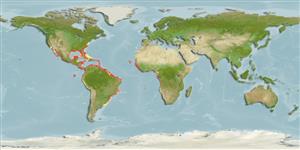Common names from other countries
Classification / Names / Names
Namen | Synonyme | Catalog of Fishes (gen., sp.) | ITIS | CoL | WoRMS
Environment: milieu / climate zone / depth range / distribution range
Ökologie
Benthopelagisch; tiefenbereich 0 - 110 m (Ref. 101598), usually ? - 20 m (Ref. 435). Tropical; 39°N - 36°S, 121°W - 14°E
Atlantic Ocean and Eastern Pacific: from USA (New Jersey to south Florida) to Brazil (Amapa to Rio Grande do Sul), including central America, the Antilles, and northern South America; West Africa from Mauritania to Angola, including Cape Verde, Sao Tome and Principe, and Annobon Islands; Eastern Pacific from California, and Baja California to Peru, including Clipperton Island and Galagapos Islands. Temperate to tropical.
Length at first maturity / Size / Gewicht / Alter
Maturity: Lm ? range ? - ? cm Max length : 5.2 cm CL Männchen/unbestimmt; (Ref. 435)
Carapace width range: 0.63 cm (Ref. 93549) to 8.2 cm (Ref. 435). Minimum depth from Ref. 104055. Benthopelagic (Ref. 97531). Occurs from the intertidal zone to a depth of 38 m, common at depths less than 20 m. Inhabits different kinds of bottom, usually covered with algae, ascidia, etc. (Ref 435). Found on sandy beaches, rocky areas as well as those with gravel (Ref. 104219). Also occurs in tide pools and rock rubble in sublittoral areas (Ref. 106321). In general, portunid crabs are reported to be mainly carnivorous (Ref. 72665).
Life cycle and mating behavior
Geschlechtsreife | Fortpflanzung | Ablaichen | Eier | Fecundity | Larven
Members of the order Decapoda are mostly gonochoric. Mating behavior: Precopulatory courtship ritual is common (through olfactory and tactile cues); usually indirect sperm transfer.
Fischer, W., G. Bianchi and W.B. Scott (eds.). 1981. (Ref. 435)
IUCN Rote Liste Status (Ref. 130435)
CITES Status (Ref. 108899)
Not Evaluated
Not Evaluated
Nutzung durch Menschen
| FishSource |
Tools
Internet Quellen
Estimates based on models
Preferred temperature
(Ref.
115969): 22.3 - 28, mean 25.5 (based on 284 cells).
Verwundbarkeit
Low vulnerability (10 of 100).
Preiskategorie
Unknown.
